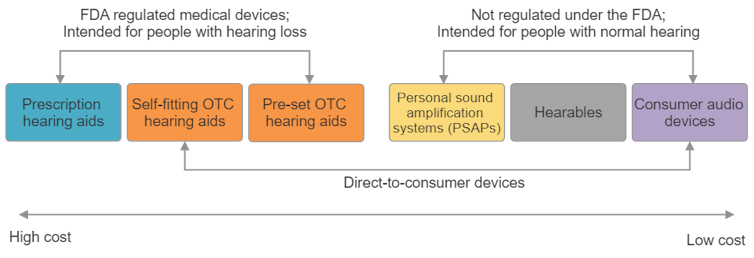Over-the-counter hearing aids offer a wide range of options – here are some of the caveats consumers
They are cheaper to buy and don’t require a doctor’s prescription. But over-the-counter hearing aids come with some stipulations.

Following the U.S. Food and Drug Administration’s ruling in August 2022, nonprescription over-the-counter hearing aids went on sale at pharmacies, supermarkets and consumer electronic stores on Oct. 17, 2022. These devices are intended only for people with perceived mild to moderate hearing loss.
For millions of Americans, these over-the-counter hearing aids are easier to access and less expensive than prescription versions. Some people view them as a tremendous innovation. Yet others say they won’t work optimally, as the device may be of poor quality, or consumers may not self-diagnose or customize the device appropriately.
As audiologists specializing in hearing care, we are actively involved in health care research and the clinical care of people with a range of hearing disorders. We have also conducted research on over-the-counter hearing aids.
Our aim is to present a balanced view on what is known about over-the-counter aids based on academic research – and provide you tips on what to know when shopping for these devices.
Hearing device categories
The newly available over-the-counter hearing aids add to a range of existing devices, including conventional prescription hearing aids and self-fitting hearing devices. Conventional hearing aids are tailored to fit by a hearing care professional. But over-the-counter devices come either in self-fitting types – meaning they adjust to the wearer’s hearing after self-testing – or preset, a type that is less individualized.
In addition, there are three other categories of hearing-related devices to be aware of. These include personal sound amplification products, which serve as hearing enhancement devices for individuals with normal hearing. A second type are called hearables, like wireless earbuds designed for listening to music or tracking fitness. The third fall under consumer audio, like headphones.
None of the products in those categories are regulated, because they are not considered medical devices. But as technology advances, many of them may have functions similar to hearing aids. In other words, all the hearing devices listed above may look similar to one another and may be hard to distinguish just by their appearance.
Because of the variety of devices on the market, you should read product labels to make sure you’re not confusing over-the-counter hearing aids with other technologies. It is not uncommon to see false advertising claims, such as personal sound amplification products or hearables advertised as over-the-counter hearing aids.
About over-the-counter aids
As noted, over-the-counter hearing aids come in two types: one-size-fits-most, with preset listening programs, and self-fitting, which can be more finely adjusted using apps on a smartphone. The latter type goes through a more rigorous government approval process and generally costs more. The least expensive ones cost around US$200, with the most running about $800. For comparison, prescription hearing aids start at roughly $1,000 and go up to approximately $6,000 per pair. The difference in cost is based on the technology level of the device as well as added services provided by hearing care professionals.

Our review of the literature on over-the counter aids revealed the following: First, several studies looking at their acoustic characteristics – that is, the degree of sound distortion and self-generated noise – found mixed results. Some over-the-counter hearing products don’t measure up to acceptable standards, whereas others do provide appropriate amplification.
Second, several large-scale consumer surveys in the U.S. and Japan suggest that users are less satisfied with over-the-counter aids than with conventional prescription hearing aids. This lower satisfaction can be primarily attributed to consumers choosing inappropriate devices or being unable to personalize or handle them.
Conversely, several clinical trials measuring the self-fitting process and the benifits of over-the-counter hearing aids generally report positive outcomes for people with mild to moderate hearing loss. More clinical trials are ongoing.
To add to the confusion, there is another caveat to those studies: Most examined early generations of direct-to-consumer hearing devices such as the personal sound amplification products – not the over-the-counter hearing aids that are now on the market. That is why consumers should take the results of those early studies with some skepticism. What’s more, as the market matures, a combination of competition and regulation will likely improve the quality of the devices.
Questions to consider before purchasing
You’ll want to take into account the look, feel and capabilities of the device. Ask yourself: Do you want a hearing aid that looks more like a wireless earbud – small and not noticeable? Is it comfortable to wear or irritating after several hours? Will it work with a smartphone and Bluetooth? How often does it need to be recharged?
Also: What is the warranty? How can I get the device fixed if it breaks? What’s the return policy? Is there free customer support after the purchase? Is the device appropriate for my particular kind of hearing issue?
Only a handful of companies now offer over-the-counter hearing aids. Some may not be in the business for very long. So choose a brand with a good reputation that stands behind its product, offers customer service assistance and lets you return the device and receive a refund if it doesn’t work for you.
Studies show that people often underestimate the severity of their hearing loss. For these people, the over-the-counter devices may not provide adequate amplification. Remember, they work only for those with mild to moderate hearing loss. In addition, some people may have treatable hearing problems, like earwax buildup, that need medical treatment instead of hearing aids.
That’s why we strongly recommend consumers get a hearing test from an audiologist before purchasing the over-the-counter hearing aids. If that is not feasible, you can take a free online hearing test and also screen yourself for risk of an ear disease or other conditions that may affect hearing. And online consumer reviews provide user reports on the perceived benefits and limitations about specific products.
If you find the over-the-counter devices don’t work for you, there may be some issues that are fixable. But if not, don’t forget: You always have the option to return them – and then, make an appointment with a hearing health care professional.
The authors do not work for, consult, own shares in or receive funding from any company or organisation that would benefit from this article, and have disclosed no relevant affiliations beyond their academic appointment.
Read These Next
Who thinks Republicans will suffer in the 2026 midterms? Republican members of Congress
The president’s party almost always loses seats in the midterms. More than two dozen Republican House…
New materials, old physics – the science behind how your winter jacket keeps you warm
Winter jackets may seem simple, but sophisticated engineering allows them to keep body heat locked in,…
Resolve to network at your employer’s next ‘offsite’ – research shows these retreats actually help f
Because they can help you get to know more of your co-workers, offsites may build the kind of trust…






